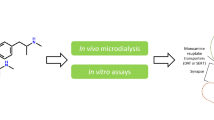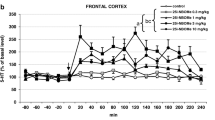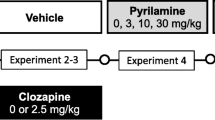Summary
The present study investigated the anorectic activity of d-fenfluramine (d-F) and the relationship with brain levels of unchanged drug and its metabolite d-norfenfluramine (d-NF) in marmosets, relating them to neurochemical effects on the serotoninergic system. d-F and d-NF were equally active in reducing food intake (ED50 about 3 mg/kg, p.o.). However, the brain concentrations of the metabolite required to reduce food intake after synthetic d-NF were more than twice those after d-F, indicating that d-NF contributes to but does not completely explain the anorectic effect of d-F. At this dose d-F did not appreciably modify the serotonin (5-HT) and 5-hydroxyindoleacetic (5-HIAA) contents of the brain regions examined, except for a slight enhancement of 5-HIAA in hippocampus. In vitro in brain cortical synaptosomes d-F inhibited [3H]5-HT uptake more potently than d-NF, as in other species. d-F and d-NF showed similar potency in stimulating [3H]5-HT release, in a Ca++ dependent manner. The tritium released by d-F and d-NF appeared to be mainly unmetabolized [3H]5-HT.
Like in other species the marmoset too has saturable and specific [3H]d-F binding sites, for which d-NF has lower affinity. d-F and d-NF have low affinities for 5-HT receptor subtypes, except that d-NF has appreciable affinity for 5-HT1Cand 5-HT1Dreceptors. Unlike in rodents but similarly to primates in the striatum the pharmacology of 5-HT receptors seems to correspond to the 5-HT1D subtype. Brain concentrations of d-F and d-NF at anorectic doses exceeded the concentrations required in vitro to influence the serotoninergic system. Therefore the effect of d-F on food intake might possibly be explained by an interaction with the 5-HT system, particularly uptake and release mechanisms, and that of d-NF by an action on 5-HT1C and 5-HT1D receptor subtypes.
Similar content being viewed by others
References
Achilli G, Perego C, Ponzio F (1985) Application of the dualcell coulometric detector: A method for assaying monoamines and their metabolites. Anal Biochem 148:1–9
Adham N, Romanienko P, Harting P, Weinshank RL, Branchek T (1992) The rat 5-hydroxytryptamine1B receptor is the species homologue of the human 5-hydroxytryptamine1Dβ receptor. Mol Pharmacol 41:1–7
Borroni E, Ceci A, Garattini S, Mennini T (1983) Differences between d-Fenfluramine and d-Norfenfluramine in serotonin presynaptic mechanisms. J Neurochem 40:891–893
Caccia S, Ballabio M, Guiso G, Rocchetti M, Garattini S (1982) Species differences in the kinetics and metabolism of fenfluramine isomers. Arch Int Pharmacodyn 258:15–28
Caccia S, Anelli M, Ferrarese A, Fracasso C, Garattini S (1992a) Single-and multiple-dose kinetics of d-fenfluramine in rats given anorectic and toxic doses. Xenobiotica 22:217–226
Caccia S, Sarati S, Anelli M, Garattini S (1992b) Effect of escalating dosese of d-fenfluramine on the content of indoles in brain. Neuropharmacology 31:875–879
Curzon G (1990) Serotonin and appetite. Ann NY Acad Sci 600:521–531
De Lean A, Munson PJ, Roadbard D (1978) Simultaneous analysis of families of sigmoidal curves: Application to bioassay, radioligand assay, and physiological dose-response curves. Am J Physiol 235:E97-E102
Gagliardini V, Mennini T, Pham P, Sahnond M, Taddei C, Fratelli M (1992) Solubilization and characterization of d-fenfluramine binding sites from bovine cerebral cortex. Eur J Pharm (in press)
Garattini S (1987) Mechanism of the anorectic activity or dextrofenfluramine. In: Bender AE, Brookes LJ (eds) Body weight control. The physiology, clinical treatment and prevention of obesity. Churchill Livingstone, Edinburgh, pp 261–270
Garattini S, Caccia S, Mennini T, Samanin R, Consolo S, Ladinsky H (1979) Biochemical pharmacology of the anorectic drug fenfluramine: a review. Curr Med Res Opin 6 [Suppl 1]:15–27
Garattini S, Mennini T, Samanin R (1989) Reduction of food intake by manipulation of central serotonin current experimental results. Br J Psychiatry 155 [Suppl 8]:41–45
Glennon RA, Raghupathi R, Bartyzel P, Teitler M, Leonhardt S (1992) Binding of Phenylalkylamine derivatives at 5-HT1C and 5-HT2 serotonin receptors: Evidence for a lack of selectivity. J Med Chem 35:734–740
Gobbi M, Taddei C, Mennini T (1988) Different components of 3H-imipramine binding in rat brain membranes: relation to serotonin uptake sites. Life Sci 42:575–583
Gobbi M, Taddei C, Mennini T (1989) In-vivo (+)-[3H] fenfluramine binding to rat brain: Biochemical and autoradiographic studies. J Pharm Pharmacol 41:253–256
Gobbi M, Frittoli E, Mennini T, Garattini S (1992) Releasing activities of d-fenfluramine and fluoxetine on rat hippocampal synaptosomes preloaded with [3H]serotonin. Naunyn-Schmiedeberg's Arch Pharmacol 345:1–6
Jones DNC, Barnes NM, Costall B, Domeney AM, Kilpatrick GJ, Naylor RJ, Tyers MB (1992) The distribution of 5-HT3 recognition sites in the marmoset brain. Eur J Pharmacol 215:63–68
Limberger N, Deicher R, Starke K (1991) Species differences in presynaptic serotonin autoreceptors: mainly 5-HT1D but possibly in addition 5-HT1D D in the rat, 5-HT1D in the rabbit and guinea-pig brain cortex. Naunyn-Schmiedeberg's Arch Pharmacol 343:353–364
Maura G, Gemignani A, Versace P, Martire M, Raiteri M (1982) Carrier-mediated and carrier-independent release of serotonin from isolated central nerve endings. Neurochem Int 4:219–224
McTavish D, Heel RC (1992) Dexfenfluramine. A review of its pharmacological properties and therapeutic potential in obesity. Drugs 43:713–733
Mennini T, Borroni E, Samanin R, Garattini S (1981) Evidence of the existence of two different intraneuronal pools from which pharmacological agents can release serotonin. Neurochem Int 3:289–294
Mennini T, Garattini S, Caccia S (1985) Anorectic effect of fenfluramine isomers and metabolites: Relationship between brain levels and in vitro potencies on serotonergic mechanism. Psycopharmacology 85:111–114
Mennini T, Gobbi M, Taddei C, Garattini S (1988) Characterization of high affinity and stereospecific [3H]d-fenfluramine binding to rat brain. Neurochem Int 13:345–351
Mennini T, Bizzi A, Caccia S, Codegoni A, Fracasso C, Frittoli E, Guiso G, Padura IM, Taddei C, Uslenghi A, Garattini S (1991) Comparative studies on the anorective activity of d-fenfluramine in mice, rats, and guinea pigs. Naunyn-Schmiedeberg's Arch Pharmacol 343:483–490
Molliver ME, Berger UV, Mamounas LA, Molliver DC, O'Hearn E, Wilson MA (1990) Neurotoxicity of MDMA related compounds: Anatomic Studies. Ann NY Acad Sci 600:640–664
Munson PJ, Roadbard D (1984) Computerrized analysis of ligand binding data: Basic principles and recent development. Roadbard D, Forti G (eds) Computers in endocrinology. Raven Press, New York, pp 117–145
Nelson DR, Thomas DR (1989) [3H]-BRL 43694 (Granisetron), a specific ligand for 5-HT3 binding sites in rat brain cortical membranes. Biochem Pharmacol 38:1693–1695
Ricaurte GA, Molliver ME, Martello MB, Katz JL, Wilson MA, Martello AL (1991) Dexfenfluramine neurotoxicity in brains of nonhuman primates. Lancet 338:1487–1488
Samanin R, Garattini S (1990) The pharmacology of serotoninergic drugs affecting appetite. In: Wurtman RJ, Wurthman JJ (eds) Nutrition and the brain, vol 8. Raven Press, New York, pp 163–192
Scherman D (1986) Dihydrotetrabenazine binding and monoamine uptake in mouse brain regions. J Neurochem 47:331–333
Wölfel R, Graefe KH (1992) Evidence for various tryptamines and related compounds acting as substrates of platelet 5-hydroxytryptamine transporter. Naunyn-Schmiedeberg's Arch Pharmacol 345:129–136
Author information
Authors and Affiliations
Additional information
Correspondence to S. Caccia at the above address
Rights and permissions
About this article
Cite this article
Caccia, S., Anelli, M., Fracasso, C. et al. Anorectic effect and brain concentrations of D-fenfluramine in the marmoset: relationship to the in vivo and in vitro effects on serotonergic mechanisms. Naunyn-Schmiedeberg's Arch Pharmacol 347, 306–312 (1993). https://doi.org/10.1007/BF00167450
Received:
Accepted:
Issue Date:
DOI: https://doi.org/10.1007/BF00167450




